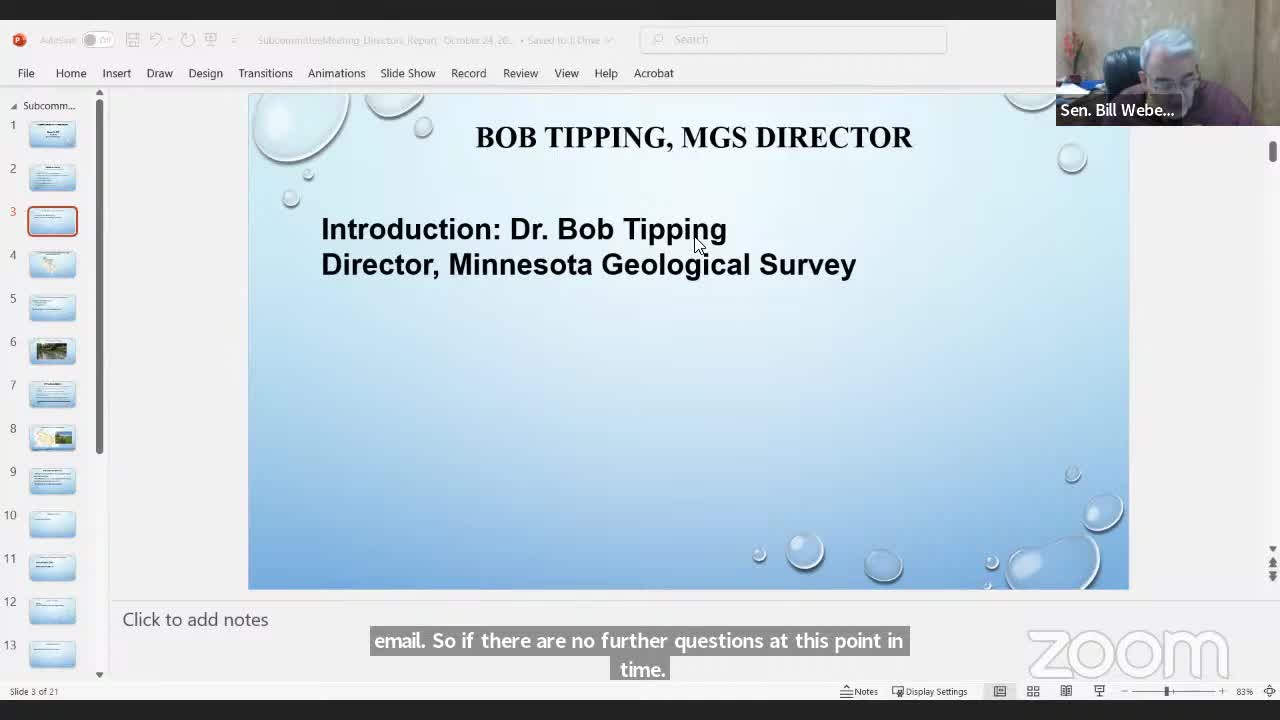New Minnesota Geological Survey director outlines statewide county‑atlas completion and watershed‑scale subsurface mapping
October 25, 2024 | Subcommittee on Minnesota Water Policy (SMWP, Departments, Joint, Committees, Legislative, Minnesota
This article was created by AI summarizing key points discussed. AI makes mistakes, so for full details and context, please refer to the video of the full meeting. Please report any errors so we can fix them. Report an error »

Dr. Bob Tipping, the newly appointed director of the Minnesota Geological Survey, introduced himself to the Subcommittee on Minnesota Water Policy on Oct. 24 and described the agency’s work on county geologic atlases and emerging watershed‑scale subsurface models.
"Most of you are familiar with MGS via the County Geologic Atlas series," Tipping said, and he described the agency’s core role: "to provide information on the container — the piece that holds our natural resources, including minerals and water." He said the atlas program is nearing statewide completion and that remaining counties are planned to be finished within about 10 years.
Tipping illustrated a watershed‑scale subsurface model produced for the Zumbro watershed area near Rochester and explained how bedrock layers (Jordan sandstone, Prairie du Chien group, St. Peter sandstone) and an intervening Decorah shale layer act as a confining "roof" that controls groundwater residence times. He said the same bedrock geometry and overlying glacial tills vary across the state and thus change how recently well water recharges and whether wells show elevated chloride or nitrate.
"If we took a sample from a Jordan well...that water would probably not have recharged in the last 50 years" in parts of the watershed where confining layers and thick till exist, Tipping said, contrasting that with areas such as Plainview where more recent recharge is expected.
Tipping said the watershed‑scale approach is a way to "stitch together county atlases" and produce models at the planning scale that can inform source‑water protection, groundwater vulnerability assessments and watershed planning. He emphasized that the county atlas program is driven by county participation and local interest from soil and water conservation districts and local water planners.
Ending: Tipping invited committee members to engage with MGS as the agency pursues watershed models and to consider county participation to advance planning‑scale subsurface information.
"Most of you are familiar with MGS via the County Geologic Atlas series," Tipping said, and he described the agency’s core role: "to provide information on the container — the piece that holds our natural resources, including minerals and water." He said the atlas program is nearing statewide completion and that remaining counties are planned to be finished within about 10 years.
Tipping illustrated a watershed‑scale subsurface model produced for the Zumbro watershed area near Rochester and explained how bedrock layers (Jordan sandstone, Prairie du Chien group, St. Peter sandstone) and an intervening Decorah shale layer act as a confining "roof" that controls groundwater residence times. He said the same bedrock geometry and overlying glacial tills vary across the state and thus change how recently well water recharges and whether wells show elevated chloride or nitrate.
"If we took a sample from a Jordan well...that water would probably not have recharged in the last 50 years" in parts of the watershed where confining layers and thick till exist, Tipping said, contrasting that with areas such as Plainview where more recent recharge is expected.
Tipping said the watershed‑scale approach is a way to "stitch together county atlases" and produce models at the planning scale that can inform source‑water protection, groundwater vulnerability assessments and watershed planning. He emphasized that the county atlas program is driven by county participation and local interest from soil and water conservation districts and local water planners.
Ending: Tipping invited committee members to engage with MGS as the agency pursues watershed models and to consider county participation to advance planning‑scale subsurface information.
View full meeting
This article is based on a recent meeting—watch the full video and explore the complete transcript for deeper insights into the discussion.
View full meeting
